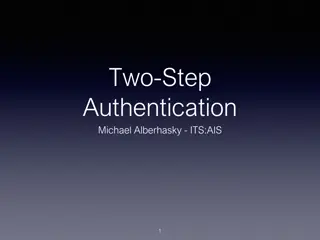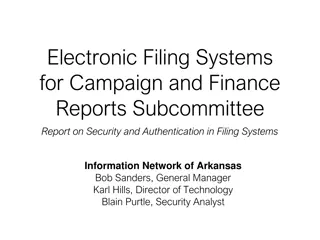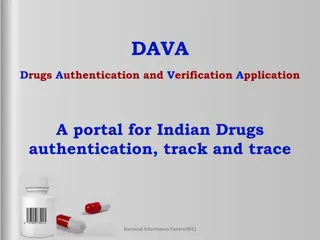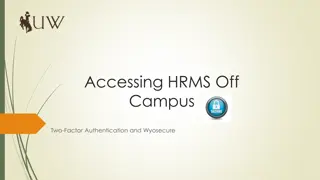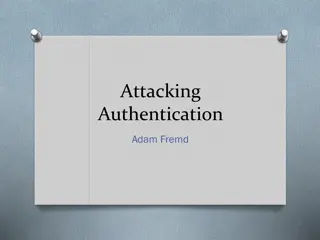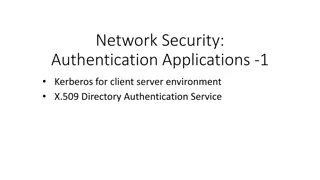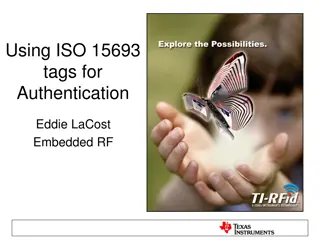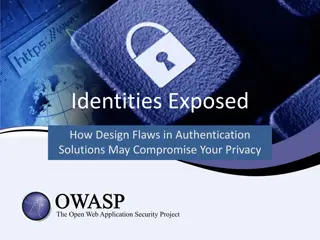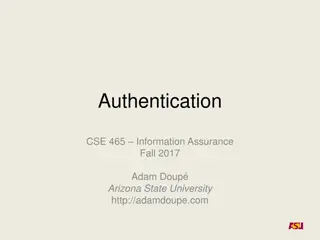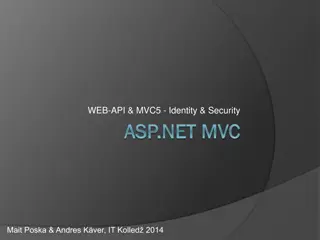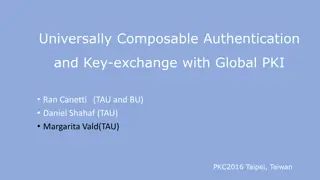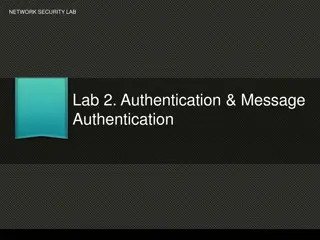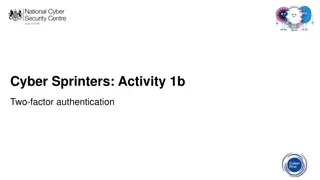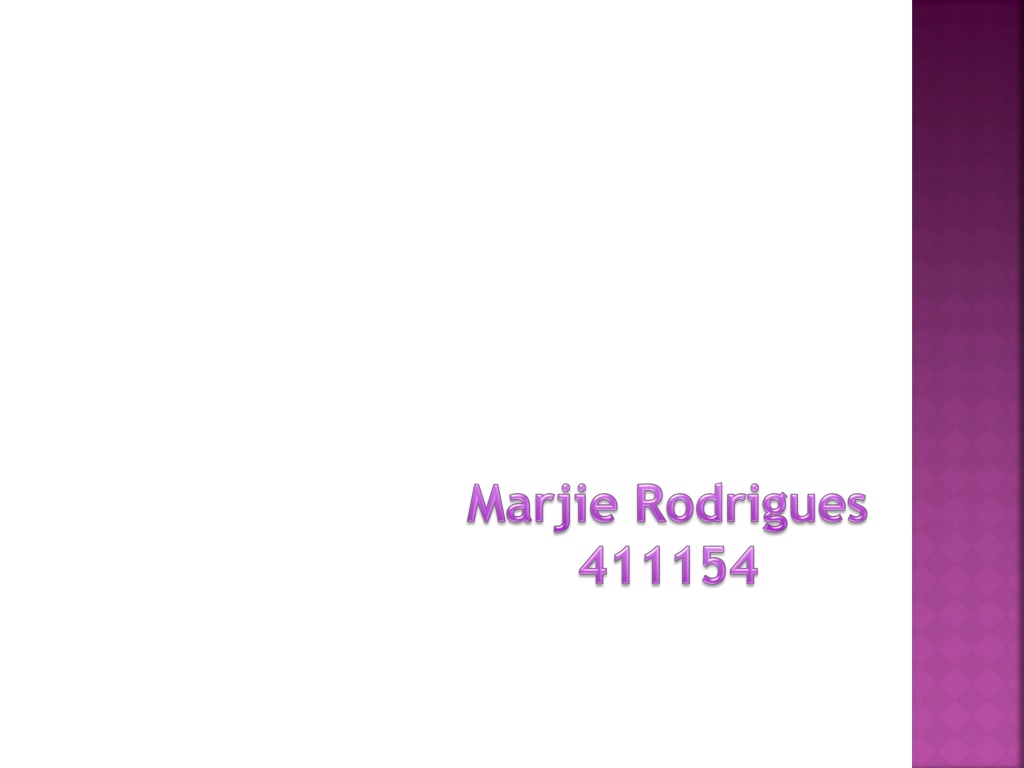
Understanding Authentication Methods and Token-Based Security
Discover the various means of authenticating user identities, from what individuals know to what they possess. Explore the concept of token-based authentication and the use of memory cards for enhanced security in user authentication processes.
Download Presentation

Please find below an Image/Link to download the presentation.
The content on the website is provided AS IS for your information and personal use only. It may not be sold, licensed, or shared on other websites without obtaining consent from the author. Download presentation by click this link. If you encounter any issues during the download, it is possible that the publisher has removed the file from their server.
E N D
Presentation Transcript
WHAT IS AUTHENTICATION ? Positive verification of identity (man or machine) Verification of a person s claimed identity Who are you? Prove it.
There are four general means of authenticating a users identity, which can be used alone or in combination: 1. Something the individual knows: Examples includes a password, a personal identification number (PIN), or answers to a prearranged set of questions.
Something the individual possesses: Examples include electronic key cards, smart cards, and physical keys. This type of authenticator is referred to as a token. The process of verifying an identity claimed by or for a system entity. An authentication process consists of two steps: Identification step: Presenting an identifier to the security system. (Identifiers should be assigned carefully, because authenticated identities are the basis for other security services, such as access control service.) Verification step: Presenting or generating authentication information that corroborates the binding between the entity and the identifier.
Token-Based Authentication Objects that a user possesses for the purpose of user authentication are called tokens.
1: Memory Cards Memory cards can store but not process data. The most common such card is the bank card with a magnetic stripe on the back. A magnetic stripe can store only a simple security code, which can be read (and unfortunately reprogrammed) by an inexpensive card reader. There are also memory cards that include an internal electronic memory.
Memory cards can be used alone for physical access, such as a hotel room. For computer user authentication, such cards are typically used with some form of password or personal identification number (PIN). A typical application is an automatic teller machine (ATM). The memory card, when combined with a PIN or password, provides significantly greater security than a password alone. An adversary must gain physical possession of the card (or be able to duplicate it) plus must gain knowledge of the PIN
Among the potential drawbacks are the following : Requires special reader: This increases the cost of using the token and creates the requirement to maintain the security of the reader s hardware and software. Token loss: A lost token temporarily prevents its owner from gaining system access. Thus there is an administrative cost in replacing the lost token. In addition, if the token is found, stolen, or forged, then an adversary now need only determine the PIN to gain unauthorized access. User dissatisfaction: Although users may have no difficulty in accepting the use of a memory card for ATM access, its use for computer access may be deemed inconvenient.
2)STRONG AUTHENTICATION SMART CARDS Smart cards are one way to provide strong authentication of users. The card itself is the item that the user must possess. The second factor may be a PIN, a password, or even a thumbprint. Various existing systems have used all of these Authentication becomes even more rigorous by requiring a functional correlation between the two factors. The contents of the smart card cannot be accessed unless the value of the second factor is read by the smart card from the reading device. Specifically, when a user presents a smart card to a reading device such as a computer, the computer reads the PIN (or other second factor) and writes it to the smart card. Only if the PIN matches will the smart card allow the other information it contains to be accessed by the computer The most important information passed by the smart card to the computer is, of course, the identity of the user. When the computer receives that identity, the authentication is complete
Biometrics Verifies an identity by analyzing a unique person attribute or behavior (e.g., what a person is ). Most expensive way to prove identity, also has difficulties with user acceptance. Many different types of biometric systems, know the most common. 13
Biometric Authentication A biometric authentication system attempts to authenticate an individual based on his or her unique physical characteristics. These include static characteristics, such as fingerprints, hand geometry, facial characteristics, and retinal and iris patterns; and dynamic characteristics, such as voiceprint and signature. In essence, biometrics is based on pattern recognition. Compared to passwords and tokens, biometric authentication is both technically complex and expensive. While it is used in a number of specific applications, biometrics has yet to mature as a standard tool for user authentication to computer systems.
PHYSICAL BIOMETRICS Advantages Cannot be disclosed, lost, forgotten Disadvantages Cost, installation, maintenance Reliability of comparison algorithms False positive: Allow access to unauthorized person False negative: Disallow access to authorized person Privacy?
Fingerprint Iris Hand Geometry Finger Geometry Face Geometry Ear Shape Retina Smell Thermal Face Hand Vein Nail Bed DNA Palm Print
BEHAVIORAL BIOMETRICS Signature Voice Keystroke
The most common are the following: Facial characteristics: Facial characteristics are the most common means of human-to-human identification; thus it is natural to consider them for identification by computer.The most common approach is to define characteristics based on relative location and shape of key facial features, such as eyes eyebrows, nose, lips, and chin shape. An alternative approach is to use an infrared camera to produce a face thermogram that correlates with the underlying vascular system in the human face
Fingerprints: Fingerprints have been used as a means of identification for centuries, and the process has been systematized and automated particularly for law enforcement purposes. A fingerprint is the pattern of ridges and Furrows on the surface of the fingertip. Fingerprints are believed to be unique across the entire human population. In practice, automated fingerprint recognition and matching system extract a number of features from the fingerprint for storage as a numerical surrogate for the full fingerprint pattern. Hand geometry: Hand geometry systems identify features of the hand, including shape, and lengths and widths of fingers.
Retinal pattern: The pattern formed by veins beneath the retinal surface is unique and therefore suitable for identification. A retinal biometric system obtains a digital image of the retinal pattern by projecting a low-intensity beam of visual or infrared light into the eye. Iris: Another unique physical characteristic is the detailed structure of the iris.
Signature: Each individual has a unique style of handwriting, and this is reflected especially in the signature, which is typically a frequently written sequence. However, multiple signature samples from a single individual will not be identical. This complicates the task of developing a computer representation of the signature that can be matched to future samples. Voice: Whereas the signature style of an individual reflects not only the unique physical attributes of the writer but also the writing habit that has developed, voice patterns are more closely tied to the physical and anatomical characteristics of the speaker. Nevertheless, there is still a variation from sample to sample over time from the same speaker, complicating the biometric recognition task.
Textbook: Operating Systems William Stallings



